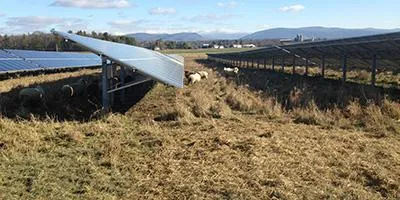Can grazing livestock, pollinator-friendly plantings, crops and bird habitat compatibly share the finite space beneath and surrounding solar array panels? How can multiple enterprises share and operate compatibly, and even complement each other on the same parcel of land and still be productive?
These are the questions we explored during this recent online workshop, looking at examples of the integration of pollinator and bird habitat, grazing livestock and crop production, and solar photovoltaic energy facilities within the Vermont landscape. Through this half-day event, experts and stakeholders assessed and addressed the scope of existing practices and barriers to adoption as well as requirements for long-term success.
View the full playlist on YouTube, or else watch individual sessions:
Introduction and overview with Matthew Burke, Postdoctoral Associate, University of Vermont, Jeannine Valcour, Research Coordinator, Gund Institute for Vermont, and Deissy Perilla Daza, Research Assistant, Leadership for the Ecozoic.
Panel 1: Working on the Ground: Land management, project development, and technology options, moderated by the Center's own Kimberly Hagen, Pasture Program Grazing Specialist
Panel 2: Connecting Across the Landscape Planning, integrating, and encouraging multifunctional solar. Moderated by Alex DePillis, Vermont Agency of Agriculture, Food & Markets Senior Agricultural Development Coordinator
Virtual Site Visits with Host Jason Mazurowski, Consulting Ecologist, Gund Institute for Environment, Mike Kiernan of bee the change, and Amber Reed, Maplemont Farm, with Kimberly Hagen.
This work was supported by an Apis Fund Award from the Gund Institute for Environment at the University of Vermont.
